Collaborative Robots Market Size
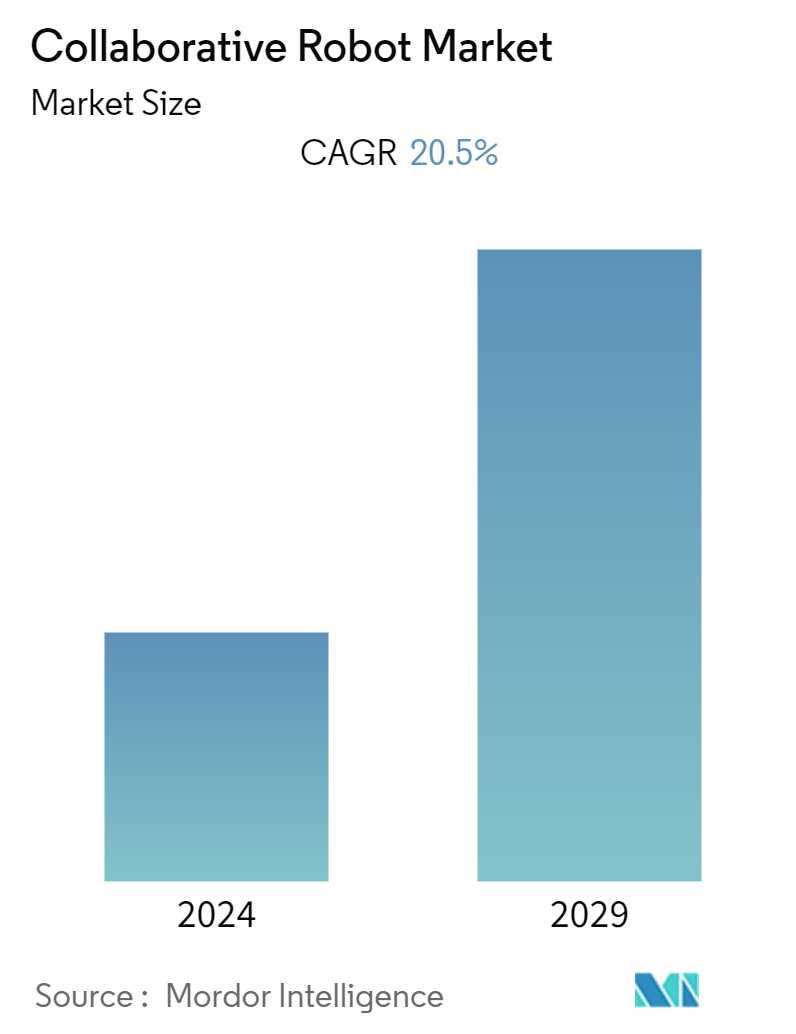
| Study Period | 2019 - 2029 |
| Base Year For Estimation | 2023 |
| CAGR (2024 - 2029) | 20.50 % |
| Fastest Growing Market | Asia Pacific |
| Largest Market | Asia Pacific |
| Market Concentration | Low |
Major Players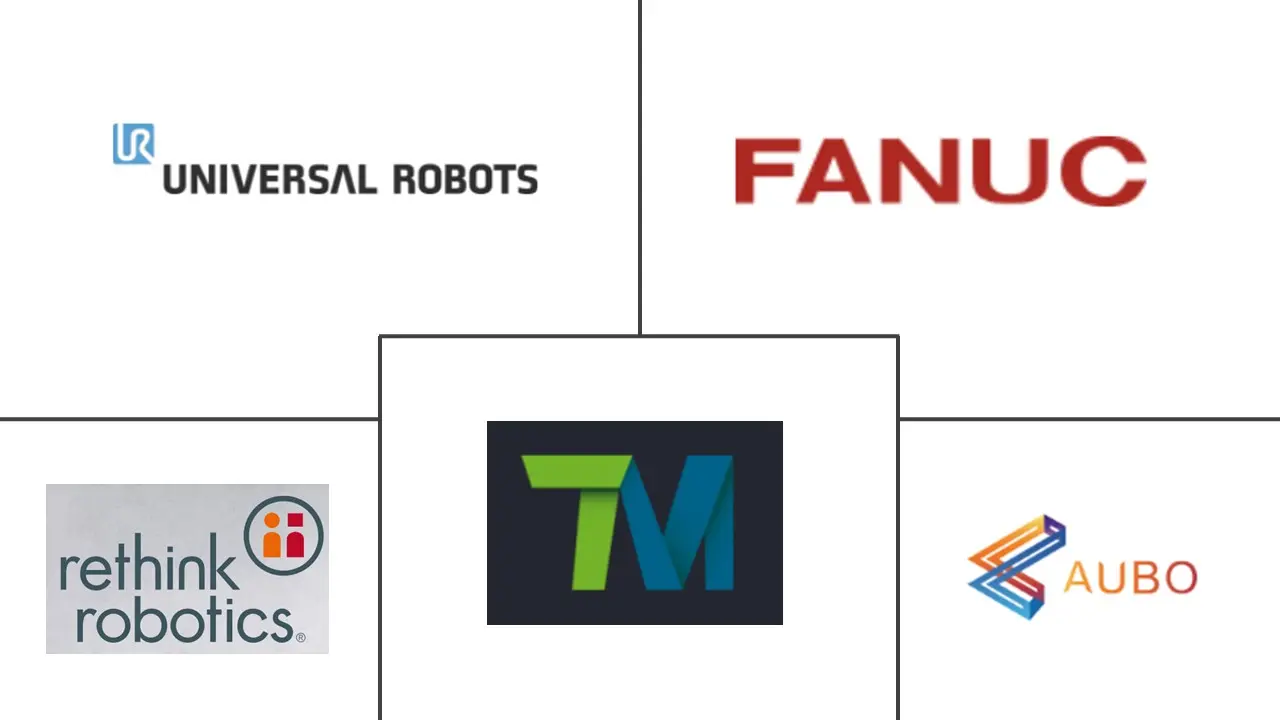
*Disclaimer: Major Players sorted in no particular order |
Collaborative Robots Market Analysis
The Collaborative Robot Market is expected to register a CAGR of 20.5% during the forecast period.
As robots work even more closely with humans, they must respond to the users and adapt their behaviors. Over the next few years, researchers are expected to recognize basic human behaviors and adapt these robots' actions to respond to them. Over the next few years, this would develop into much more advanced programs that could adapt to the needs of complex tasks.
- Robust growth in advanced technologies, such as digital twins, virtual reality (VR), augmented reality (AR), and developments in offline programming and simulation software, enables companies to optimize robot performance. It also helps them develop and test different configurations to find the best solution for their requirements.
- Edge computing is an interesting new approach to network architecture that helps businesses break beyond the limitations of traditional cloud-based networks. As innovative machines like autonomous robots and medical sensors become more common, edge computing will significantly impact society.
- Rapid advancements in artificial intelligence (AI) enable them to execute tasks accurately in a continuously changing environment. AI-integrated cobots help manufacturers in various applications that make operations run efficiently, smoothly, and productively. AI-driven cobots recognize the orientation and presence of materials, perform testing and inspection, dynamically pick and place tasks, read results post-inspection, and derive decisions accordingly.
- Longer training and onboarding, increasing benefits and compensation rates, and labor shortages are significant factors driving the deployment. More and more warehousing, distribution, and fulfillment facilities are investing in automated solutions. As technology improves and the applications become broader and more flexible, robotics is being adopted by a more significant number of manufacturing operations across regions.
- The robots integrated with advanced technologies cost high as compared to traditional robots. The costs of robotic systems are associated with robust hardware and efficient software. Automation equipment involves the usage of advanced automation technologies that require high capital investment. For instance, an automated system may cost millions of Dollars for design, fabrication, and installation.
Collaborative Robots Market Trends
Automotive End-User Segment is Expected to Hold Significant Market Share
- The automotive sector is witnessing significant growth in the number of units produced per day. The machinery on the production floor requires proper maintenance to shorten production cycles and increase production output. Cobots can easily achieve lower direct unit production costs. Moreover, depending on the assembly process considered, the throughput can be higher than in traditional robotic systems. These cobots are used in the automotive industry, where they can be applied to auto part manufacturing (assembling significant parts of a vehicle) and finished vehicle assembly.
- Collaborated robotics used for automotive applications are experiencing a massive upsurge in recent times owing to the proliferation of automotive plants in eminent Asian nations, including China, India, and Vietnam, and growing demand for automotive robotics from automakers in North America. Various prominent automakers, including BMW, Mercedes Benz, and Ford, have been deploying cobotson on their production floors to carry out myriad functions such as welding, car painting, and assembly line activities.
- The automotive industry has utilized robots in its assembly lines for various manufacturing processes for the past few years. Automakers are researching the use of robotics in even more processes, as cobots are accurate, flexible, more efficient, and dependable on these production lines. This has allowed the automotive industry to remain one of the most automated supply chains globally and one of the largest robot users. According to IFR, global industrial robot shipments will amount to about 518,000 in 2024.
- In April 2022, an automotive manufacturing company, Fiat, a subsidiary of Stellantis NV, invested EUR 700 million (USD 750 million) at its Mirafiori factory to produce 500 electric vehicles using state-of-the-art technology, such as collaborative robots. The company aims to automate its complex assembly line operations and quality controls, installing 11 cobots from Universal Robots A/S.
- The cobots used by Fiat would perform various assembly tasks, including quality control, screwdriving, dispensing, and visual inspection. In line with these initiatives, the company would use collaborative automation robots to free the operators from physically demanding and repetitive manual tasks so that they can be employed on processes with greater added value. Such initiatives by the companies in the market are expected to further fuel the demand for collaborative robots in the automotive industry.
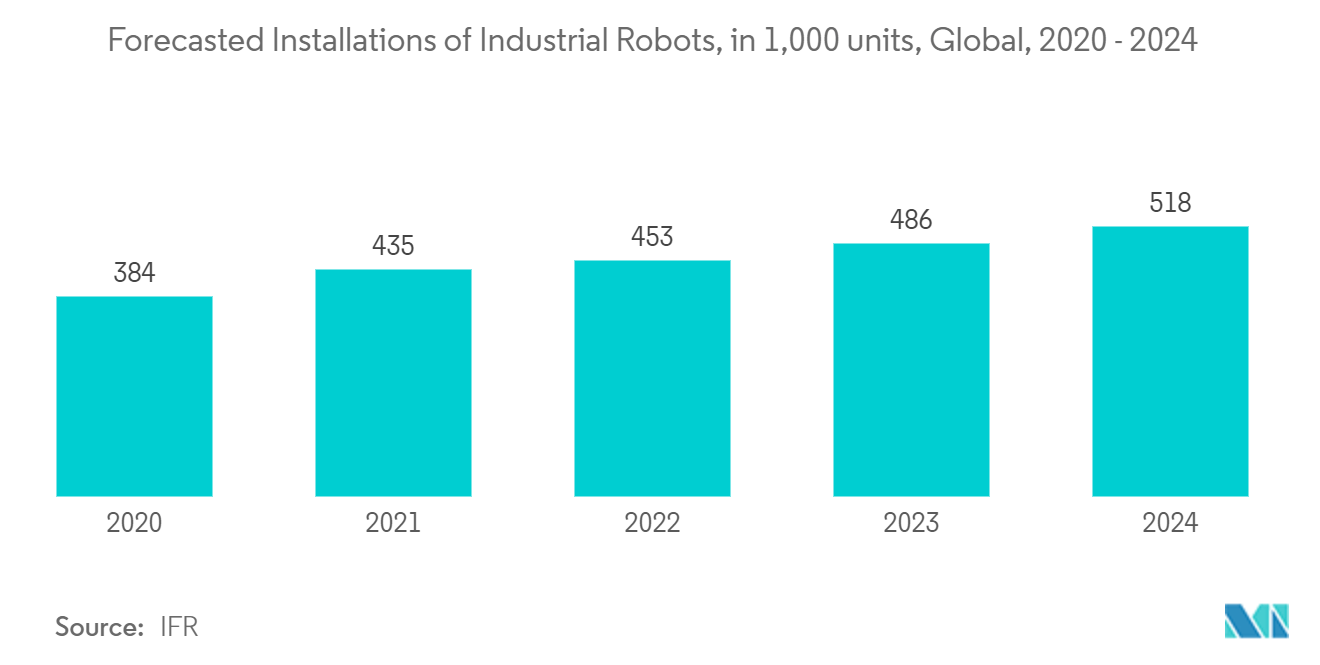
Asia Pacific is Expected to Hold Significant Market Share
- The market for collaborative robots in the Asia Pacific is expanding significantly due to the growing number of industries in the region and their integration with automation to increase the ROI. The Asia Pacific collaborative market is predicted to be dominated by China with the growing production, sales, and trade of cobots in China.
- The Chinese market for collaborative robots is leading over the EMEA and Americas regions as the country continues to take industrial automation as the primary focus goal. For instance, the Ministry of Industry and Information Technology (MIIT) in Beijing released the "14th Five-Year Plan" for Robot Industry Development on 21st December 2021, focusing on promoting innovation to make China a global leader in robot technology and industrial advancement by including it in 8 critical industries for the next five years. As a result, the essential unique program "Intelligent Robots" was launched under the National Key R&D Plan on 23rd April 2022 with a funding of USD 43.5 million.
- In India, the collaborative robot market is significantly observing steady growth as many processes in the Indian market are not clearly standardized, and a large number of businesses still run in an unstructured way with lower levels of digitization compared to other developed markets.
- Moreover, India has a proven track record of implementing Industry 4.0 in small and medium enterprises through regional and national initiatives by the Government of India and MSMEs themselves. These enterprises have spearheaded the implementation of Industry 4.0 through digital MSME schemes by converting the existing infrastructure into digital, cloud-based technologies. With the industries getting digitized, one of the powerful technologies that evolved in Industry 4.0 is collaborative robots, which have paramount importance in contributing to Industry 4.0 and have made significant breakthroughs by creating an intelligent manufacturing environment.
- Japan is rapidly moving toward "Society 5.0", thus introducing the fifth chapter to the four major stages of human development in this new ultra-smart society. All things are connected through IoT technology, and all technologies are getting integrated, dramatically improving the quality of life. To realize this new era, the Government of Japan is taking various suitable steps to encourage numerous players, including start-ups and "hidden gems" among small- and medium-sized organizations, to come up with brand-new and innovative ideas for facilitating the world with solutions with problems such as labor shortages owing to population.
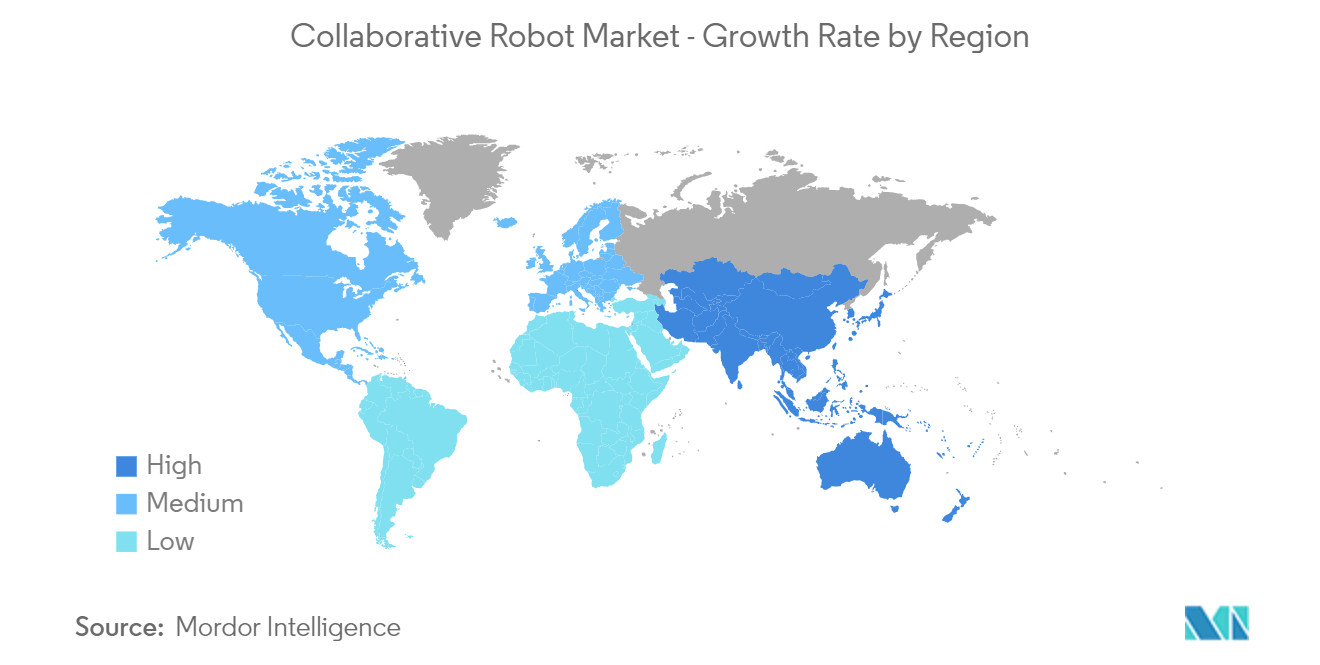
Collaborative Robots Industry Overview
The collaborative robot market is highly fragmented, with the presence of many major players like Universal Robots AS, Fanuc Corp., TechMan Robot Inc., Rethink Robotics GmbH, AUBO Robotics USA, and ABB Ltd, among others. These players in the market use partnerships, mergers, innovations, investments, and acquisitions to improve their products and gain a competitive edge over others.
- February 2023 - Rapid Robotics announced a new collaboration with Universal Robots (UR), in which UR would supply collaborative robot arms for Rapid Robotics' deployment of cobot work cells across North America. Through this agreement, the company will be able to remove further obstacles to automation by using a robotic workforce to fill positions that manufacturers are unable to fill.
- November 2022 - TechmanRobot introduced its TM AI Cobotseries of collaborative robots, which combines a powerful and precise robot arm with a native AI inferencing engine and smart vision system. It is an intelligent robotic arm series with a comprehensive AI software suite, including TM AI+ Training Server, TM AI+ AOI Edge, TM Image Manager, and TM 3DVisionTM, facilitating companies to train and tailor their system to precisely meet their application.
Collaborative Robots Market Leaders
-
Universal Robots AS
-
Fanuc Corp.
-
TechMan Robot Inc.
-
Rethink Robotics GmbH
-
AUBO Robotics USA
*Disclaimer: Major Players sorted in no particular order
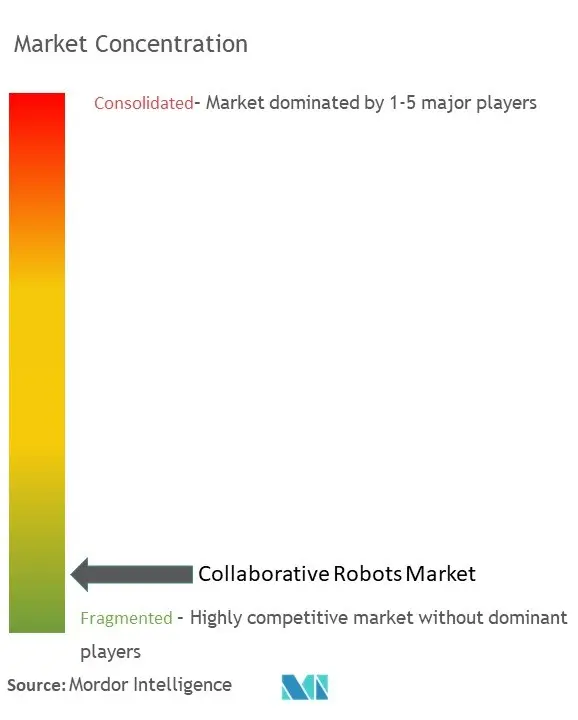
Collaborative Robots Market News
- May 2023 - Techman Robot introduced a new line of collaborative robots. The TM AI Cobot S Series features a payload capacity of 25 kg in the TM25S model - making it highly suitable for a wide range of industrial applications.
- April 2023 - Doosan Robotics announced the launch of its E-SERIES, the company's NSF-certified collaborative robot line specifically created for the food and beverage industry. By reducing weight and adopting a slim design, the new series is easy to install and fits into workspaces seamlessly.
Collaborative Robots Market Report - Table of Contents
1. INTRODUCTION
1.1 Study Assumptions and Market Definition
1.2 Scope of the Study
2. RESEARCH METHODOLOGY
3. EXECUTIVE SUMMARY
4. MARKET INSIGHTS
4.1 Market Overview
4.2 Industry Attractiveness - Porter's Five Forces Analysis
4.2.1 Bargaining Power of Suppliers
4.2.2 Bargaining Power of Buyers
4.2.3 Threat of New Entrants
4.2.4 Intensity of Competitive Rivalry
4.2.5 Threat of Substitute Products
4.3 Industry Value Chain Analysis
4.4 Impact of COVID-19 on the Market
4.5 Pricing Analysis
5. MARKET DYNAMICS
5.1 Market Drivers
5.1.1 Advancements in Edge Computing & AI Leading to Easier Implementation
5.1.2 Increasing Demand for Automation in Various Industrial Processes
5.2 Market Restraints
5.2.1 High Initial Investment and the Requirement of Skilled Workforce
6. MARKET SEGMENTATION
6.1 By Payload
6.1.1 Less Than 5Kg
6.1.2 5-9 Kg
6.1.3 10-20 Kg
6.1.4 More Than 20 KG
6.2 By End-user Industry
6.2.1 Electronics
6.2.2 Automotive
6.2.3 Manufacturing
6.2.4 Food and Beverage
6.2.5 Chemicals and Pharmaceutical
6.2.6 Other End-user Industries
6.3 By Application
6.3.1 Material Handling
6.3.2 Pick and Place
6.3.3 Assembly
6.3.4 Palletizing and De-palletizing
6.3.5 Other Applications
6.4 By Geography
6.4.1 North America
6.4.1.1 United States
6.4.1.2 Canada
6.4.2 Europe
6.4.2.1 United Kingdom
6.4.2.2 Germany
6.4.2.3 France
6.4.3 Asia
6.4.3.1 China
6.4.3.2 India
6.4.3.3 Japan
6.4.3.4 Australia and New Zealand
6.4.4 Latin America
6.4.4.1 Brazil
6.4.4.2 Mexico
6.4.5 Middle East and Africa
6.4.5.1 United Arab Emirates
6.4.5.2 Saudi Arabia
7. COMPETITIVE LANDSCAPE
7.1 Company Profiles
7.1.1 Universal Robots AS
7.1.2 Fanuc Corp.
7.1.3 TechMan Robot Inc.
7.1.4 Rethink Robotics GmbH
7.1.5 AUBO Robotics USA
7.1.6 ABB Ltd.
7.1.7 Kawasaki Heavy Industries Ltd.
7.1.8 Precise Automation Inc.
7.1.9 Siasun Robot & Automation co. Ltd.
7.1.10 Staubli International AG
7.1.11 Omron Corporation
7.1.12 Festo Group
7.1.13 Epson Robots(Seiko Epson)
7.1.14 KUKA AG
- *List Not Exhaustive
8. INVESTMENT ANALYSIS
9. FUTURE OF THE MARKET
Collaborative Robots Industry Segmentation
Collaborative robots are designed to work with humans and are built with safety features such as integrated sensors, passive compliance, and overcurrent detection. The integrated sensors feel external forces, and if the force is too high, they halt the robot's movement.
The Collaborative Robot Market is segmented by payload (less than 5 kg, 5-9 kg, 10-20 kg, and more than 20 kg), end-user industry (electronics, automotive, manufacturing, food and beverage, chemicals and pharmaceutical), application (material handling, pick and place, assembly, palletizing & de-palletizing), and geography (North America (United States, Canada), Europe (United Kingdom, Germany, France, Rest of Europe ), Asia Pacific (China, India, Japan, Rest of Asia Pacific) Latin America (Brazil, Mexico, Rest of Latin America), and Middle East and Africa (United Arab Emirates, Saudi Arabia, Rest of Middle East and Africa)). The market sizes and forecasts are provided in terms of value in USD for all the above segments.
| By Payload | |
| Less Than 5Kg | |
| 5-9 Kg | |
| 10-20 Kg | |
| More Than 20 KG |
| By End-user Industry | |
| Electronics | |
| Automotive | |
| Manufacturing | |
| Food and Beverage | |
| Chemicals and Pharmaceutical | |
| Other End-user Industries |
| By Application | |
| Material Handling | |
| Pick and Place | |
| Assembly | |
| Palletizing and De-palletizing | |
| Other Applications |
| By Geography | ||||||
| ||||||
| ||||||
| ||||||
| ||||||
|
Collaborative Robots Market Research FAQs
What is the current Collaborative Robot Market size?
The Collaborative Robot Market is projected to register a CAGR of 20.5% during the forecast period (2024-2029)
Who are the key players in Collaborative Robot Market?
Universal Robots AS, Fanuc Corp., TechMan Robot Inc., Rethink Robotics GmbH and AUBO Robotics USA are the major companies operating in the Collaborative Robot Market.
Which is the fastest growing region in Collaborative Robot Market?
Asia Pacific is estimated to grow at the highest CAGR over the forecast period (2024-2029).
Which region has the biggest share in Collaborative Robot Market?
In 2024, the Asia Pacific accounts for the largest market share in Collaborative Robot Market.
What years does this Collaborative Robot Market cover?
The report covers the Collaborative Robot Market historical market size for years: 2019, 2020, 2021, 2022 and 2023. The report also forecasts the Collaborative Robot Market size for years: 2024, 2025, 2026, 2027, 2028 and 2029.
What are the major factors driving the Collaborative Robots Market?
The major factors driving the Collaborative Robots Market are a) Government support for automation and Industry 4.0 adoption encouraging cobot implementation b) Growing automation needs and labor shortages
Collaborative Robots Industry Report
The global collaborative robot market is witnessing a significant surge, driven by the demand for automation across industries. Cobots, designed to work alongside humans, are gaining popularity for their flexibility, ease of programming, and ability to perform tasks ranging from material handling to quality testing. Particularly beneficial for SMEs due to their cost-effectiveness, the automotive sector has become a major end-user, utilizing cobots for enhancing productivity. The Asia Pacific region leads this growth, supported by industrial automation and government initiatives. Despite challenges like high initial costs and the need for skilled labor, the market is set for robust expansion. Collaborative robots companies are increasingly integrating cobots into operations to stay competitive. Statistics from Mordor Intelligence™ highlight the market's share, size, and revenue growth, offering insights into the collaborative robot market forecast and historical overview. For a deeper understanding, a free report PDF download is available, showcasing the potential and benefits of cobots in the evolving industrial landscape.
The report provides an in-depth industry analysis and industry information, shedding light on industry outlook and industry reports. The industry research encompasses various industry sales and industry size metrics, supported by industry statistics and industry trends. Market data is meticulously gathered, offering a comprehensive market forecast and insights into market growth. The report also identifies market leaders and provides a detailed market outlook and market overview. Through market predictions and market review, it emphasizes the importance of market segmentation and market value. An illustrative report example and a downloadable report PDF are available for further reference. Research companies have contributed significantly to this report, ensuring a thorough understanding of the collaborative robot market.



